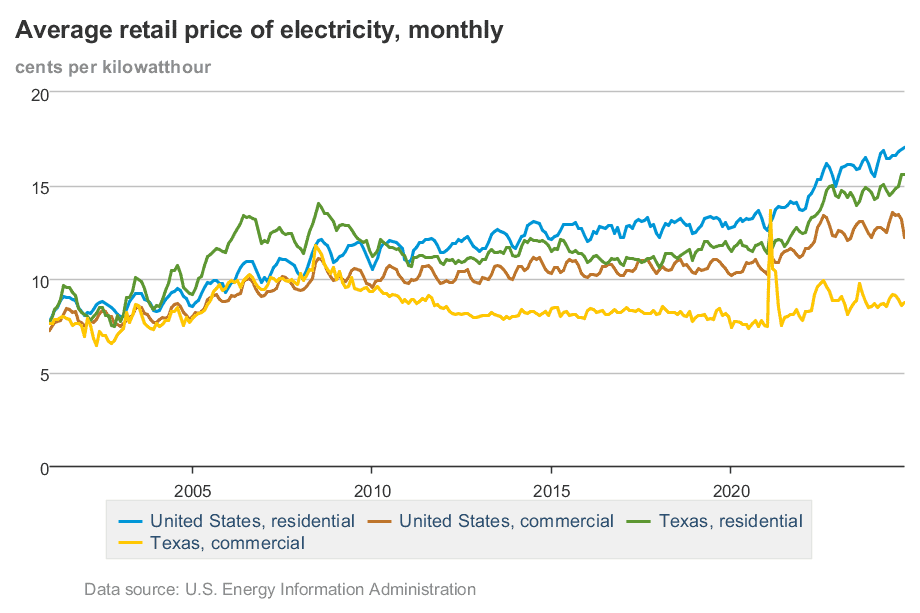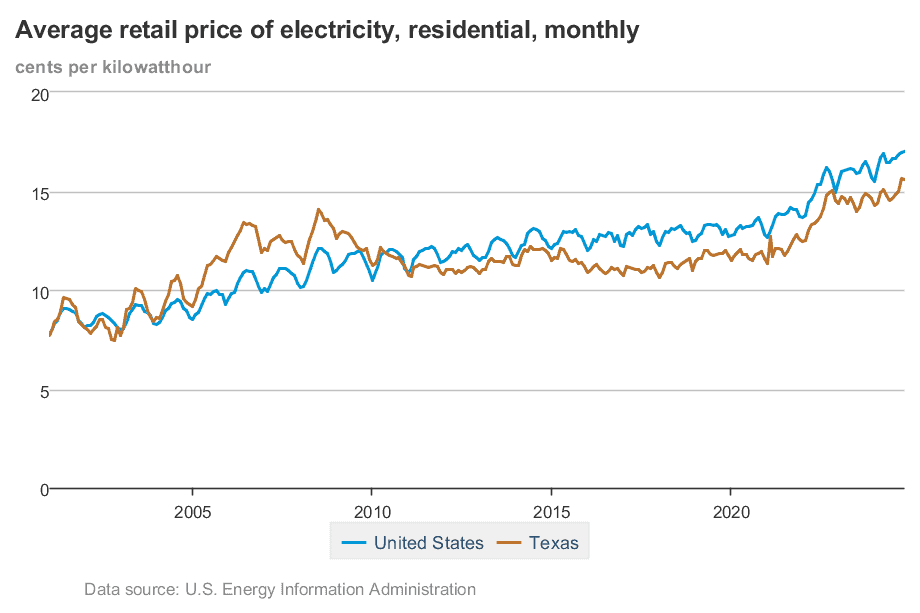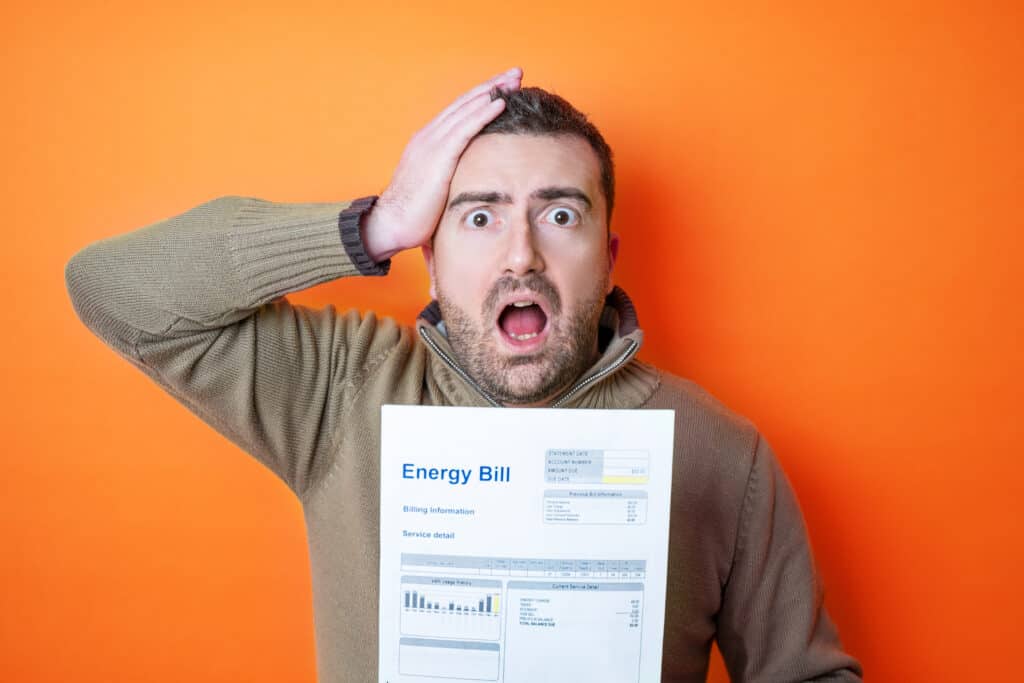Texas Electricity Price Forecast 2025
Texas electricity prices in 2025 are expected to decline slightly due to increased solar energy production and lower wholesale costs.
However, rising natural gas prices and growing demand from data centers may impact retail rates.
The best way to manage your energy costs is to compare rates regularly and lock in a fixed-rate plan when prices are low.
Key Takeaways for 2025
- Retail Electricity Prices May Fluctuate: Lower wholesale rates don’t always mean lower bills. Infrastructure costs and rising demand could keep residential prices unpredictable. (Source: EIA)
- Projected Wholesale Price Decline: ERCOT market rates are projected to average $27 per MWh, a 22% decrease from 2024, thanks to growing renewable capacity. (Source: EIA)
- Natural Gas Prices Expected to Rise: The cost of natural gas, a major electricity driver, is forecasted to rise 24%, reaching $3.37/MMBtu, which could offset wholesale price drops. (Source: Reuters)
- Texas’ Solar Boom: With 26 GW of new solar capacity, Texas is reinforcing its position as a renewable energy leader, reducing reliance on fossil fuels. (Source: EIA)
- Data Centers Driving Demand: Expanding data centers, particularly in the Dallas-Fort Worth region, are adding pressure to the grid, which could affect pricing stability. (Source: Reuters)
Will Texas Electricity Rates Rise or Fall in 2025?
While wholesale electricity prices are expected to decline due to the expansion of renewable energy sources, factors like rising natural gas prices and increased demand from large-scale commercial operations may counterbalance those decreases.
Consumers can expect modest retail price stability, with potential increases during peak demand periods.
Key Influencing Factors
- Lower Wholesale Prices: A direct result of the growing renewable energy sector, primarily solar power expansion.
- Fluctuating Natural Gas Costs: Although renewable energy is increasing, natural gas still accounts for much of Texas’ power generation.
- Grid Stability Risks: Extreme weather events could affect supply, potentially causing temporary rate spikes.

What’s Driving Texas Electricity Prices in 2025?
Recent extreme weather caused Texas power prices to swing from negative to triple the average. Understanding this volatility can help you choose the right time to lock in rates.
1. Natural Gas Price Fluctuations
Natural gas remains a major component of Texas’ energy mix, and its price trajectory will influence electricity costs. With the projected increase to $3.37/MMBtu, Texans may see slightly higher costs for power generated from natural gas plants. (Source: Reuters)
2. Renewable Energy Growth
Texas leads the nation in renewable energy production. The addition of 26 GW of new solar capacity in 2025 is expected to stabilize electricity prices in the long term, offering relief to consumers through lower-cost energy sources. (Source: EIA)
3. Increased Energy Demand from Data Centers
The state’s expanding data center sector is placing significant demand on the grid. This increased demand could lead to localized rate spikes, especially in urban centers like Dallas and Austin. (Source: Reuters)
4. Extreme Weather Events
The impact of severe weather, such as winter storms or extreme summer heat, continues to be a wildcard. Consumers should prepare for potential short-term rate increases during extreme weather periods.
Residential Electricity Price Forecast
The EIA estimates a 2% increase in average U.S. residential electricity prices in 2025.
However, Texas’ deregulated market allows consumers to find competitive rates by comparing providers and securing fixed-rate plans when prices are low. (Source: EIA)

Compare Texas Electricity Prices
Find the most affordable electricity rates today for different residential energy usage patterns.
How Texans Can Save on Electricity in 2025
- Lock in Competitive Fixed Rates – Take advantage of lower wholesale prices by securing a fixed-rate plan when market rates dip.
- Compare Electricity Plans – Use comparison tools to find the best deal tailored to your home’s energy consumption patterns.
- Optimize Energy Usage – Implement energy-efficient appliances and strategies to reduce overall consumption.
- Consider Renewable Options – Look for green energy plans that include solar or wind energy for potential long-term savings.
Take Control of Your Energy Costs
With Texas electricity prices projected to decline in 2025, now is the time to act.
Compare rates, lock in a favorable plan, and implement energy-saving strategies to maximize your savings.
Texas Electricity Prices FAQs
Here are the most common questions we are asked about Texas Electricity Prices.
What is the average residential electricity price in Texas?
The average residential electricity price in Texas is 15.30 ¢/kWh, or 8% less than the United States average.
Updated July 2025
Source: U.S. Energy Information Administration (EIA)
Will Texas electricity prices go down in 2025?
Wholesale prices are expected to decrease, but retail rates may fluctuate due to demand and market factors.
What affects Texas electricity prices the most?
Natural gas prices, renewable energy growth, demand from large-scale users, and extreme weather.
Seasonal fluctuations, such as high demand during hot summer months, can cause electricity prices to rise.
What is the average business / commercial electricity price in Texas?
The average commercial electricity price in Texas is 8.73 ¢/kWh, 29% lower than the United States average.
What electricity company has the best prices in Texas?
In the state of Texas, there are over 60 retail electric companies, each with dozens of energy plans available to consumers. However, the best electricity price for your home depends on your kWh usage, not the company.
Using Compare Power, you can explore energy plans that align with your home’s usage history to quickly find the one that best fits your kWh usage profile, regardless of the provider.
How do utilities and energy providers differ?
Utility companies are responsible for maintaining and operating the energy grid.
In a power outage, you can depend on them to restore and maintain the power lines and other equipment that delivers energy to your home or business.
Utility companies serving Texas include Oncor Electric Delivery, Centerpoint Energy, AEP Texas, and Texas-New Mexico Power.
What is ERCOT in Texas?
ERCOT manages most of Texas’ grid, providing power to over 26 million Texans, and is a nonprofit organization. The Texas Legislature and the Public Utility Commission have regulatory oversight over ERCOT’s operations.
Why is my electricity bill so high all of a sudden?
Texas heavily relies on natural gas to generate electricity, with over half of the state’s power being sourced from natural gas.
Unfortunately, economic uncertainty has caused natural gas prices to soar to all-time highs, leading to a steady increase in electricity prices throughout the year.
Retail electricity providers (REPs) purchase electricity in advance based on their demand predictions. As electricity becomes more expensive, REPs raise prices to ensure that they can maintain their profit margins.
If your electricity contract has expired, you may be paying a holdover rate that varies each month and is significantly more expensive than a fixed-rate contract.
Take control of your electricity costs by using Compare Power. Shop with your zip code to discover the best plans for your home and avoid high energy bills.
What is considered a good electricity rate in Texas?
A good electricity rate in Texas typically ranges from 10¢ to 13¢ per kWh for residential customers. However, rates vary based on location, usage patterns, and market conditions.
The best way to determine a good rate for your situation is to compare offers from multiple providers using a tool like Compare Power.
Why do electricity rates vary in Texas?
Electricity rates in Texas vary due to fuel costs, seasonal changes in demand, transmission and distribution charges, and the provider’s operational costs.
Additionally, Texas has a deregulated energy market, meaning consumers can choose from numerous providers and plans, leading to a wide range of rates.
Are electricity rates going up or down in Texas?
Electricity rates in Texas can fluctuate based on market conditions, fuel costs, and other factors.
However, per the U.S. Energy Information Administration’s forecast for 2025, wholesale power prices are expected to decrease due to lower natural gas costs and increased renewable energy generation.
Can I choose my electricity provider in Texas?
Yes, Texas has a deregulated energy market, meaning consumers can choose their electricity provider from several options.
You can compare different providers and plans to find the best one for your needs.
When is the best time to lock in a rate?
During periods of low demand, such as spring or fall, when prices tend to be lower.
How do Texas electricity prices compare to other states?
Texas electricity prices are generally lower than the national average.
As of July 2025, the average residential rate in Texas was 15.30 ¢/kWh, or 8% less than the United States average.
This is mainly due to Texas’ deregulated electricity market, which promotes competition among providers, and the state’s diverse energy mix, including significant wind power generation.
How can I find the best electricity plan in Texas?
Compare providers regularly and monitor the market for price drops.
Any product or company names, marks, or logos shown on this page are the property of their respective owners. Compare Power is an unaffiliated, independent marketplace. Get unbiased, accurate information backed by our commitment to editorial integrity.
Call us at 855-441-3030 Monday through Friday, 8:30 a.m. to 6:30 p.m., or Saturday, 9:00 a.m. to 4:30 p.m.









